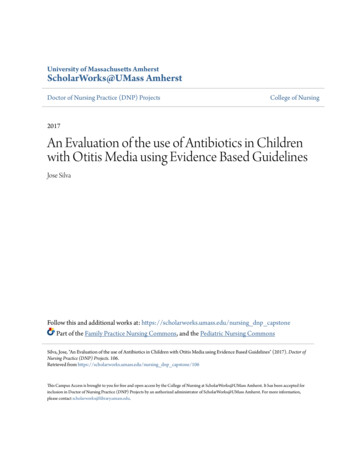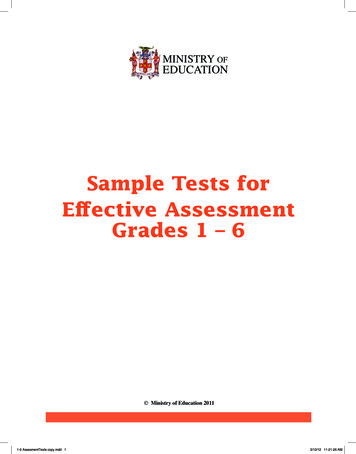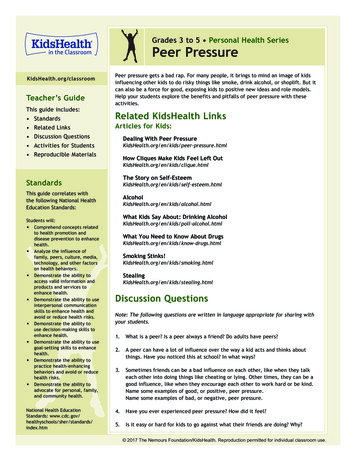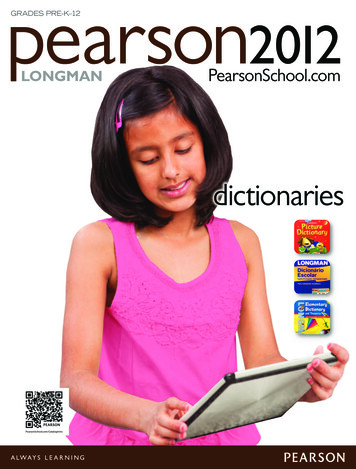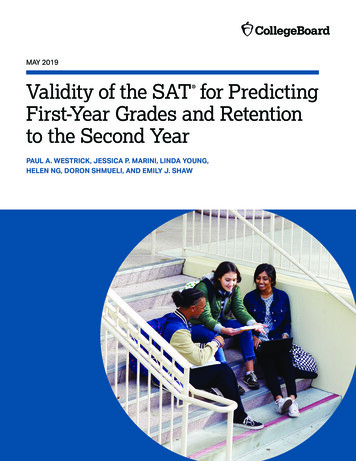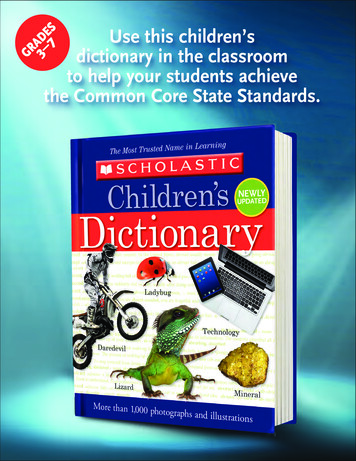
Transcription
Gr3–ad7esUse this children’sdictionary in the classroomto help your students achievethe Common Core State Standards.
How the Scholastic Children’s Dictionary HelpsStudents Achieve the Common Core State StandardsThe Common Core State Standards require thatstudents learn how to use reference materials suchas dictionaries. The Scholastic Children’s Dictionarycontains features to help students fully understandwords through definitions, sample sentences, and theThesaurus, and also helps students to learn standardEnglish through the Punctuation Guide, GrammarGuide, and Idiom Guide. These features of thedictionary will help students to learn new words andrecognize them when they read and also use themwhen they speak and write.To help your students learn new words and becomebetter readers, teach them to use context clues tofigure out the meaning of unfamiliar words, andthen check the Scholastic Children’s Dictionary to seeif they are correct. Encourage students to read allparts of the word entry in the dictionary. If there ismore than one meaning of the word, tell students tocarefully choose the correct meaning, check the partof speech, and read the example sentence. Also teachstudents to check the spelling of the word and thepronunciation if they are unsure how to say it. Deepunderstanding and repeated exposure to words helpsstudents add these words to their vocabularies.As with most tools, students need to learn howto use them correctly. Teach students how to usethe features of the Scholastic Children’s Dictionaryto help them independently monitor and checktheir word comprehension. Learning to use thedictionary independently will ensure that theyunderstand complex text, academic discussions, andall conversations to help them become college andcareer ready.Teaching Students the FeaturesMake sure students know how to independently use the dictionary to: Look up unfamiliar words alphabetically and decidewhich definition is appropriate, if there is more thanone meaning. Refer to the Synonym boxes and the Thesaurus sectionto learn words with similar meanings for furtherclarification. Read the “About this letter” feature, which introduceseach letter through a Spelling Hint or otheruseful information about the letter. Learn about the parts of a word, parts of speech, and otherinformation about a word by reading the Language Noteboxes. Use the phonetic spelling to pronounce the word. Refer to the Grammar Guide to find information aboutthe parts of speech, the four kinds of sentences, andcommon grammar terms. Learn the part of speech that matches the definition. Understand the word and its definition by seeing it inaction through a sample sentence. Refer to the photographs, paying close attention to thelabels, for more clarity. Read the Word History boxes to find out the origins ofthe word. Read the Prefix and Suffix boxes to learn the meaning ofthe affix and how it changes the meaning of the root word. Use the Punctuation Guide to try out new types ofpunctuation or understand why an author chooses topunctuate in certain ways. Use the Pronunciation Guide to learn which lettersrepresent each sound. Familiarize themselves with the Idiom Guide to understand and recognize figurative language in conversationsand in complex text. Look up and learn new words about technology.
Overview of How to Use This DictionaryA dictionary is a reference book that provides all kinds of information about words. This dictionary is your students’guidebook to the English language. Teach students to reference it to find out what a word means, check its spellingor pronunciation, or figure out how to use it in a sentence. Synonym boxes suggest similar words to help studentsadd variety to their writing and their speech.“About this letter” boxesappear on the openingpage of each new letter.In each one, students willfind a fact about that letteror a spelling tip for wordscontaining that letter’ssound.Tabs help students quicklylocate the section of thealphabet that they arelooking for.Entries are listed inalphabetical order. Manywords have severaldifferent meanings anduses that are listed underdifferent numbers withinthe entry. Some entries haveillustrations or photographs.ABCDEFGHIJKLMLanguage tips appearthroughout the dictionary.Word History boxes describethe interesting origins ofthe word highlighted inthe boxes. Prefix, Suffix,Synonym, and LanguageNote boxes provide extrainformation about the usageof a word or word part.Main entry words areset in red type and jut outfrom the meanings so it iseasy to locate words.NOPQRSTUVWXYZAaAbout A Each letter in our alphabet began as a drawing of an animal,object, or person. A probably was first drawn upside down like a V,with a bar across the middle. It may have stood for the horns of an ox,since farmers used to guide oxen by a rope attached to a bar acrosstheir horns. Our alphabet has its origins in an alphabet developed bythe Phoenicians. Aleph, the first letter of their alphabet, meant “ox.”a indefinite articleabbreviate verb To make something shorter, such as1. Any: Pick a card.2. One: I have a car.3. Per: They traveled more than 200 miles a day duringthe trip.a (uh or ay)aardvark noun An African mammal with a long,sticky tongue that it uses to catch insects. aard·vark(ahrd-vahrk)a word: Most people abbreviate words like “road” and“street” in addresses. ab·bre·vi·ate (uh-bree-vee-ate) verb abbreviating, abbreviated adjective abbreviatedabbreviation noun A shortened version of a word. Forexample, St. is an abbreviation of the word street. Seethe Initials, Acronyms, and Abbreviations Guide in theReference Section. ab·bre·vi·a·tion(uh-bree-vee-ay-shuhn)abdicate verb To give up power: When the queenabdicated the throne, her son became king. ab·di·cate(ab-di-kate) verb abdicating, abdicated nounabdicationabdomen noun1. The front part of your body between your chestand hips.2. The rear section of an insect’s body.ab·do·men (ab-duh-muhn)abduct verb To take someone away by force: Twomasked men abducted the millionaire’s wife. ab·duct(ab-duhkt) verb abducting, abducted nounabductionabhor verb To hate something: Alix abhors romanticmovies. ab·hor (ab-hor) verb abhorring, abhorred adjectiveabhorrentabide verb If you abide by a rule,agreement, or law, you obey it ordo what it requires: Players whocannot abide by the rules will bedisqualified. a·bide (uh-bide) verbabiding, abided or abode (uh-bohd)ability noun1. The mental or physical power to dosomething: Sybil has the ability to be a greatmathematician.2. Skill, as in a natural ability at golf.a·bil·i·ty (uh-bil-i-tee) noun, plural abilitiesablaze adjective On fire: The building was ablaze whenthe firemen arrived. a·blaze (uh-blaze)able adjective1. If you are able to do something, you can do it.Word HistoryThe aardvark owes its name to the Afrikaanslanguage, which is spoken in South Africa, wherethese animals are found. In this language, aardmeans “earth” and vark means “pig.” Aardvark wastherefore the perfect term for this piglike animal thatdigs in the ground to hunt for ants and termites.abacus noun A frame with rows of sliding beadson wires, used for adding, subtracting, multiplying,and dividing. ab·a·cus (ab-uh-kuhs) noun, pluralabacuses or abaci (ab-uh-sye or ab-uh-kye)abalone noun A large sea snail with a flat shell whosemeat people eat and whose shell lining isshiny like a pearl. ab·a·lo·ne(ab-uh-loh-nee)abandon verb1. To leave somewhere or someoneand not return: The war forcedthousands of people to abandontheir homes.2. To give up: Never abandonhope!a·ban·don (uh-ban-duhn) verb abandoning, abandonedabaloneabandoned adjective Deserted orno longer used, as in an abandonedfarm. a·ban·doned (uh-ban-duhnd)abate verb To become less intense: We delayed ourerrands till the storm abated. a·bate (uh-bate) verb abating, abatedabbey noun A group of buildings including a churchwhere monks or nuns live and work. ab·bey (ab-ee)10
Dictionary Entries Close UpNumbers appear at thebeginning of each meaningwhen a word has morethan one meaning. Themost frequently usedmeanings generallyappear first.Pronunciations, locatedin parentheses, let studentsknow how to pronouncewords. Direct studentsto use the PronunciationGuide on page 9 to learnmore about which lettersrepresent each sound. Notethat if the pronunciation of aword changes depending onits meaning, the appropriatepronunciation appears withthe appropriate meaning.Part of speech labelsusually appear on thefirst lines of entries. Notethat if the word’s part ofspeech changes with themeaning, then the part ofspeech label starts eachnew meaning. When ameaning shows the wordas a part of a commonphrase, which is knownas an idiom, no part ofspeech is given.Usage labels tell studentsif a meaning of a word isinformal or slang. Informalwords are used in everydayspeech but not usually informal speech or in writing.Many slang terms ormeanings are very popularfor a short period of time.Like informal words, theyare not appropriate informal writing such asterm papers and essays.satellite noun1. A spacecraft that is sent into orbit around theearth, the moon, or another heavenly body.2. A moon or other heavenly body that travelsin an orbit around a larger heavenly body.See moon.sat·el·lite (sat-uh-lite)attribute1. (at-ruh-byoot) noun A quality orcharacteristic that belongs to or describesa person or thing: Kindness is her greatestattribute.2. (uh-trib-yoot) verb When you attributesomething to someone, you give him or hercredit for it: The author attributed her successto her ninth-grade English teacher. verb attributing, attributedat·trib·uterap1. verb To hit something with a quick, sharpblow: Bettina rapped on the window. noun rap2. noun A type of popular music in which thewords are spoken rhythmically to a musicalbackground. noun rapper verb rap3. verb (slang) To talk: The boys rapped for hours.rap (rap)Rap sounds like wrap. verb rapping, rappedHomophones, wordsthat sound alike but havedifferent spelling andmeanings, are listed at ornear the end of a definition.Cross-references tellstudents where to turn inthe dictionary for moreinformation about themain entry word.Definitions tell themeanings of words. Whenthe main entry word is usedwithin the definition, it isprinted in boldface.Sample sentencesappear in italics aftersome of the meanings.These sentences illustratehow a word is used byshowing it in context.Syllable breaks areindicated by small dots.Entries made up of twoseparate words or two wordsand a hyphen are not brokeninto syllables. To find theirsyllables, guide studentsto look up each part ofthe term separately. Forexample, to find the syllablebreaks for solar energy, lookup solar and energy.Related words and wordforms appear at the endof an entry or at the end ofa meaning. This dictionaryalso lists irregular pluralforms for noun entries, -erand -est forms for adjectives,and irregular, -ed, and -ingforms for verbs.
Conventions of Standard EnglishTeach students to use the Scholastic Children’s Dictionary to practicestandard English grammar when they speak and write.Demonstrate command of the conventions of standard English grammar and usage whenwriting or speaking.Self-Correcting GrammarAs you listen to students speak and review their writing, takenote of ways they can communicate more clearly by learningabout standard grammar such as the correct parts of speechand types of sentences. Help students recognize correct andincorrect usage of parts of speech by reading their writingaloud and by paying attention when they speak. Guidestudents to self-correct by referring to the Grammar Guidewhenever necessary. For example, if you notice that studentsare frequently shifting verb tense, teach a mini-lesson onverb tense, and show students how to refer to the GrammarGuide independently to see examples.Demonstrate command of the conventions of standard English capitalization, punctuation,and spelling when writing.Experimenting withPunctuationAs students read books independently, ask them to lookfor various uses of punctuation. Teach them to notice thepunctuation at the end of sentences as well as other typesof punctuation, including dashes, parentheses, ellipses, andquotation marks. Ask students to choose a piece of writingthey have already written. Then ask them to refer to thePunctuation Guide in the Scholastic Children’s Dictionary tohelp them choose new types of punctuation to add to theirwriting. Have students work with a partner or small group todiscuss which piece of writing is more interesting. Remindstudents to refer to the Punctuation Guide whenever theyare writing to make their writing more interesting throughpunctuation choice.Learning to Spell CorrectlyEncourage students to attempt to spell any word they canthink of—even if they are not sure how to correctly spell it.Guide students to try to spell the word phonetically and thenlook it up in the Scholastic Children’s Dictionary to check thecorrect spelling. Also, guide students to the PronunciationGuide to help them learn how to read the phonetic spellingwritten in parenthesis in the word entry correctly.Choosing FrequentlyConfused WordsChoosing the right words when students write can bechallenging, but it is especially hard when students arechoosing the correct homophone. Until these words becomeautomatic, teach students to look up one of homophones inthe dictionary and check the meaning. If the word they lookup does not match the meaning they are looking for, guidethem to refer to the homophone list at the end of the entry.Then tell students to look up the homophone until they findthe word that matches the meaning.Knowledge of LanguageUse knowledge of language and its conventions when writing, speaking, reading, or listening.Focusing on Word ChoiceEncourage students to get excited about trying new words.Help them to choose the perfect word to express the exactmeaning they want to convey. Guide students to brainstormwords that convey their ideas
then check the Scholastic Children’s Dictionary to see if they are correct. Encourage students to read all parts of the word entry in the dictionary. If there is more than one meaning of the word, tell students to carefully choose the correct meaning, check the part of speech, and read the example sentence. Also teach students to check the spelling of the word and the pronunciation if they .

